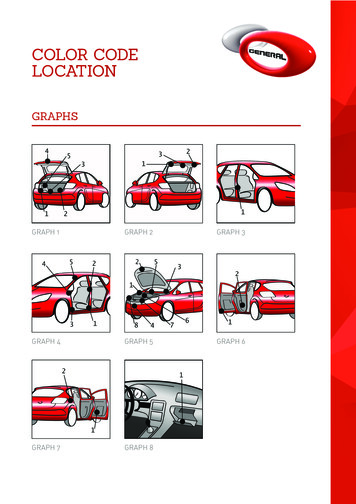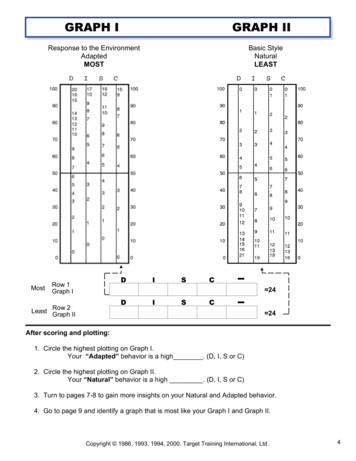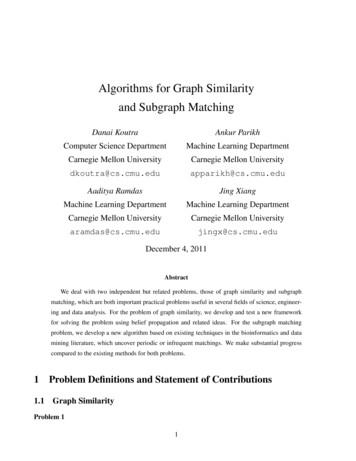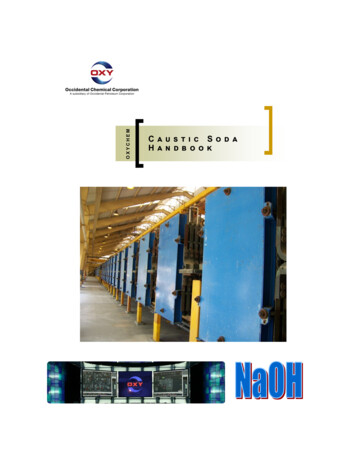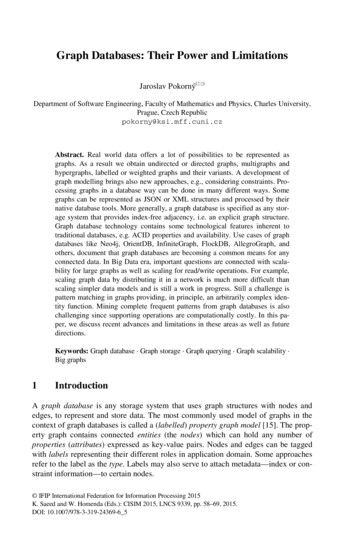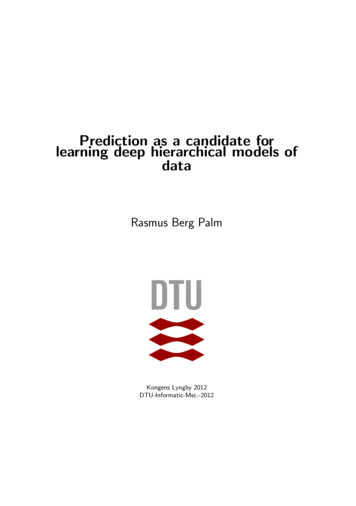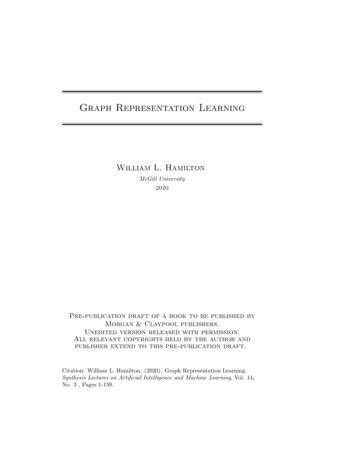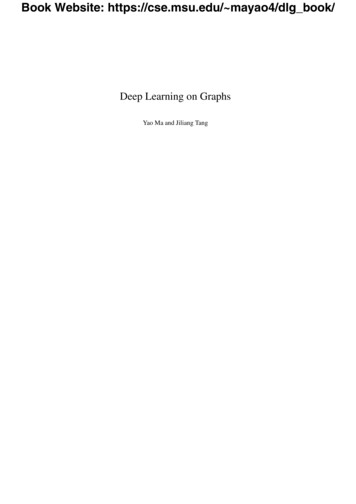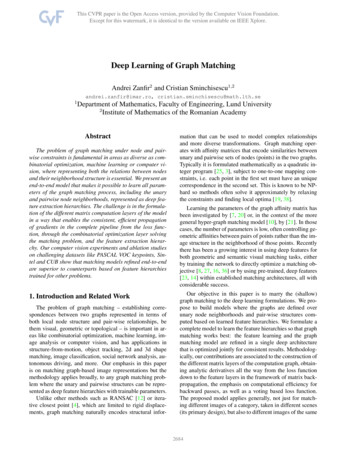
Transcription
Deep Learning of Graph MatchingAndrei Zanfir2 and Cristian Sminchisescu1,2andrei.zanfir@imar.ro, cristian.sminchisescu@math.lth.se1Department of Mathematics, Faculty of Engineering, Lund University2Institute of Mathematics of the Romanian AcademyAbstractThe problem of graph matching under node and pairwise constraints is fundamental in areas as diverse as combinatorial optimization, machine learning or computer vision, where representing both the relations between nodesand their neighborhood structure is essential. We present anend-to-end model that makes it possible to learn all parameters of the graph matching process, including the unaryand pairwise node neighborhoods, represented as deep feature extraction hierarchies. The challenge is in the formulation of the different matrix computation layers of the modelin a way that enables the consistent, efficient propagationof gradients in the complete pipeline from the loss function, through the combinatorial optimization layer solvingthe matching problem, and the feature extraction hierarchy. Our computer vision experiments and ablation studieson challenging datasets like PASCAL VOC keypoints, Sintel and CUB show that matching models refined end-to-endare superior to counterparts based on feature hierarchiestrained for other problems.1. Introduction and Related WorkThe problem of graph matching – establishing correspondences between two graphs represented in terms ofboth local node structure and pair-wise relationships, bethem visual, geometric or topological – is important in areas like combinatorial optimization, machine learning, image analysis or computer vision, and has applications instructure-from-motion, object tracking, 2d and 3d shapematching, image classification, social network analysis, autonomous driving, and more. Our emphasis in this paperis on matching graph-based image representations but themethodology applies broadly, to any graph matching problem where the unary and pairwise structures can be represented as deep feature hierarchies with trainable parameters.Unlike other methods such as RANSAC [12] or iterative closest point [4], which are limited to rigid displacements, graph matching naturally encodes structural infor-mation that can be used to model complex relationshipsand more diverse transformations. Graph matching operates with affinity matrices that encode similarities betweenunary and pairwise sets of nodes (points) in the two graphs.Typically it is formulated mathematically as a quadratic integer program [25, 3], subject to one-to-one mapping constraints, i.e. each point in the first set must have an uniquecorrespondence in the second set. This is known to be NPhard so methods often solve it approximately by relaxingthe constraints and finding local optima [19, 38].Learning the parameters of the graph affinity matrix hasbeen investigated by [7, 20] or, in the context of the moregeneral hyper-graph matching model [10], by [21]. In thosecases, the number of parameters is low, often controlling geometric affinities between pairs of points rather than the image structure in the neighborhood of those points. Recentlythere has been a growing interest in using deep features forboth geometric and semantic visual matching tasks, eitherby training the network to directly optimize a matching objective [8, 27, 16, 36] or by using pre-trained, deep features[23, 14] within established matching architectures, all withconsiderable success.Our objective in this paper is to marry the (shallow)graph matching to the deep learning formulations. We propose to build models where the graphs are defined overunary node neighborhoods and pair-wise structures computed based on learned feature hierarchies. We formulate acomplete model to learn the feature hierarchies so that graphmatching works best: the feature learning and the graphmatching model are refined in a single deep architecturethat is optimized jointly for consistent results. Methodologically, our contributions are associated to the construction ofthe different matrix layers of the computation graph, obtaining analytic derivatives all the way from the loss functiondown to the feature layers in the framework of matrix backpropagation, the emphasis on computational efficiency forbackward passes, as well as a voting based loss function.The proposed model applies generally, not just for matching different images of a category, taken in different scenes(its primary design), but also to different images of the same2684
scene, or from a video.2. Problem FormulationInput. We are given two input graphs G1 (V1 , E1 ) andG2 (V2 , E2 ), with V1 n and V2 m. Our goalis to establish an assignment between the nodes of the twographs, so that a criterion over the corresponding nodes andedges is optimized (see below).Graph Matching. Let v {0, 1}nm 1 be an indicator vector such that via 1 if i V1 is matched toa V2 and 0 otherwise, while respecting one-to-one mapping constraints. We build a square symmetric positive matrix M Rnm nm such that Mia;jb measures how wellevery pair (i, j) E1 matches with (a, b) E2 . For pairsthat do not form edges, their corresponding entries in thematrix are set to 0. The diagonal entries contain node-tonode scores, whereas the off-diagonal entries contain edgeto-edge scores. The optimal assignment v can be formulated asv argmax v Mv, s.t. Cv 1, v {0, 1}nm 1 (1)vnm nmThe binary matrix CP RencodesPone-to-one mapping constraints: a i via 1 and i a via 1. Thisis known to be NP-hard, so we relax the problem by dropping both the binary and the mapping constraints, and solvev argmax v Mv, s.t. kvk2 1(2)(in our formulation, this is an optimization problem, solvedusing eigen-decomposition) and finally the full feature extraction hierarchy used to compute the unary and pair-wisepoint representations.2.1. Derivation PreliminariesIn practice, we build an end-to-end deep network thatintegrates a feature extracting component that outputs therequired descriptors F for building the matrix M. We solvethe assignment problem (2) and compute a matching lossL(v ) between the solution v and the ground-truth. Thenetwork must be able to pass gradients w.r.t the loss functionfrom the last to the first layer. The key gradients to compute– which we cover in §3 – are L/ M and L/ F. Thiscomputation could be difficult in the absence of an appropriate factorization, as the computational and memory costsbecome prohibitive. Moreover, as some of our layers implement complex matrix functions, a matrix generalizationof back-propagation is necessary [15] for systematic derivations and computational efficiency. In the sequel we coverits main intuition and refer to [15] for details.Matrix backpropagation. We denote A : B Tr(A B) vec(A)vec(B) . For matrix derivatives, ifwe denote by f a function that outputs f (X) Y and byL the network loss, the basis for the derivation starts fromthe Taylor expansion of the matrix functions [26] at the twolayers. By deriving the functional L expresssing the totalvariation dY in terms of dX,vThe optimal v is then given by the leading eigenvector ofthe matrix M. Since M has non-negative elements, by using Perron-Frobenius arguments, the elements of v are in as the confidencethe interval [0, 1], and we interpret viathat i matches a.Learning. We estimate the matrix M parameterized interms of unary and pair-wise point features computed overinput images and represented as deep feature hierarchies.We learn the feature hierarchies end-to-end in a loss function that also integrates the matching layer. Specifically,given a training set of correspondences between pairs ofimages, we adapt the parameters so that the matching minimizes the error, measured as a sum of distances betweenpredicted and ground truth correspondences. In our experiments, we work with graphs constructed over points thatcorrespond to the 2d image projections of the 3d structureof the same physical object in motion (in the context ofvideos), or over point configurations that correspond to thesame semantic category (matching instances of visual categories, e.g. different birds). The main challenge is thepropagation of derivatives of the loss function through a factorization of the affinity matrix M, followed by matchingdY L(dX)(3)and then using that L L L f: dX : L(dX) L () : dX X Y Y(4)we obtain the equality (L f )/ X L ( L/ Y), whereL is the adjoint operator of L. This recipe for finding thepartial derivatives is used across all of our network layers.The derivations of L and L are layer-specific and are givenin the following sections.2.2. Affinity Matrix FactorizationZhou and De la Torre [38] introduced a novel factorization of the matrix M that is generally applicable to all stateof-the-art graph matching methods. It explicitly exposes thegraph structure of the set of points and the unary and pairwise scores between nodes and edges, respectively,M [vec(Mp )] (G2 G1 )[vec(Me )](H2 H1 ) (5)where [x] represents the diagonal matrix with x on themain diagonal, and is the Kronecker product. The matrix2685
Mp Rn m represents the unary term, measuring nodeto-node similarities, whereas Me Rp q measures edgeto-edge similarity; p, q are the numbers of edges in eachgraph, respectively. The two matrices encode the first-orderand second-order potentials. To describe the structure ofeach graph, we define, as in [38], the node-edge incidencematrices as G, H {0, 1}n p , where gic hjc 1 ifthe cth edge starts from the ith node and ends at the j thnode. We have two pairs, {G1 , H1 } {0, 1}n p and{G2 , H2 } {0, 1}m q , one for each image graph.One simple way to build Me and Mp isMe XΛY , Mp U1 U2 1. Given A1 , A2 , recover the matrices G1 , H1 , G2 , H2 , such that A1 G1 H 1 , A 2 G 2 H22. Given F1 , F2 , build X, Y according to (7)3. Build Me XΛY 4. Given U1 , U2 , build Mp U1 U2 5. Build M according to (5) and make G1 , H1 , G2 , H2available for the upper layers(6)where X Rp 2d and Y Rq 2d are the per-edge featurematrices, constructed such that for any cth edge that startsfrom the ith node and ends at the j th node, we set the edgedescriptor as the concatenation of the descriptors extractedat the two nodesXc [F1i F1j ], Yc [F2i F2j ]Forward pass.(7)The matrices F1 , U1 Rn d and F2 , U2 Rm d containper-node feature vectors of dimension d, extracted at possibly different levels in the network, and Λ is a 2d 2d blocksymmetric parameter matrix. Superscripts 1, 2 indicate overwhich input image (source or target) are the features computed.3. Deep Network Optimization for GraphMatchingBackward pass. Assuming the network provides L/ Me and L/ Mp , this layer must return L/ F1 , L/ F2 , L/ U1 and L/ U2 ; it must also compute L/ Λ in order to update the matrix Λ. We assume L/ Me and L/ Mp as input, and not L/ M,because the subsequent layer can take advantage of thisspecial factorization for efficient computation. We note thatmatrix Λ must have the following form in order for M tobe symmetric with positive elementsΛ , Λij 0, i, j(9) L L: dMe : d(XΛY ) Me Me L : (dXΛY XdΛY XΛdY ) Me L L YΛ : dX X Y : dΛ Me Me L XΛ : dY(10) MeWe identify the terms L LYΛ X Me L L X Y Λ Me L LXΛ Y Me(8)The Affinity Matrix layer receives as input the required hierarchy of features, and the adjacency matrices A1 and A2used to reconstruct the optimal G1 , H1 , G2 , H2 matrices,which verify the equations (8). It is easier to describe theconnectivity of the graphs by adjacency matrices than bynode-edge incidence matrices, but we still need the latter forefficient backward passes at higher layers of the network.Next, we describe the forward and the backward passes ofthis layer, as parts of the trainable deep network.Λ2Λ1dL 3.1. Affinity Matrix Layer A1 G1 H 1 , A2 G2 H2Λ1Λ2Writing the variation of the loss layer in terms of the variation of edge matrix and using the recipe (4),In this section we describe how to integrate and learnthe graph matching model end-to-end, by implementing therequired components in an efficient way. This allows us toback-propagate gradients all the way from the loss functiondown to the feature layers. The main components of ourapproach are shown in Fig. 1.If we define the node-to-node adjacency matrices A1 {0, 1}n n , A2 {0, 1}m m , with aij 1 if there is anedge from the ith node to the j th node, then (11)To compute the partial derivatives L/ F1 and L/ F2 ,we identify and sum up the corresponding 1 d sub-blocksin the matrices L/ X and L/ Y. The partial derivative L/ Λ is used to compute the derivatives L/ Λ1 and L/ Λ2 . Note that in implementing the positivity condition from (9), one can use a ReLU unit.2686
Deep Feature ExtractorAffinity MatrixIn: I1 , I2Out: features matrices F1 , F2 andU1 , U2 as computed by any CNN,at certain levels of the hierarchy,e.g. VGG-16 [29]In: F1 , F2 , U1 , U2Build graph structure:G 1 , G 2 , H1 , H2Computations: build Me and MpOut: M as given by eq. (5) Power IterationBi-StochasticVotingIn: v Computations: reshape v to amatrix and apply eqs. (19)Out: double-stochasticconfidence matrix SIn: S Rn mComputations: softmax(αS)Parameters: scale αOut: displacement vector d asgiven by eq. (22) In: MComputations: v0 1,vk 1 Mvk / Mvk Out: v Loss gtIn: d,PdOut: L(d) i φ(di dgti )Figure 1: Computational pipeline of our fully trainable graph matching model. In training, gradients w.r.t. the loss functionare passed through a deep feature extraction hierarchy controlling the unary and pair-wise terms associated to the nodes andedges of the two graphs, the factorization of the resulting affinity matrix, the eigen-decomposition solution of the matchingproblem, and the voting-based assignment layer. For each module we show the inputs, outputs and the key variables involved.Detailed derivations for the associated computations are given in the corresponding paper sections.3.2. Power Iteration Layerthe symmetry of M, we deriveComputing the leading eigenvector v of the affinity matrix M can be done using power iterationsvk 1 MvkkMvk k (I vk 1 vk 1) L v : dM kMvk k vk 1 k (I vk 1 vk 1) L: dvk MkMvk k vk 1dL (12)We initialize v0 1. We use k·k as the ℓ2 norm, k·k2 .Forward pass. We run the assignment from (12) for Niterations, and output the vector v vN . Recall thatM Rnm nm , where n, m are the number of nodes ineach graph and p, q respectively the number of edges, thetime complexity of the forward pass, per power iteration,is O(n2 m2 ), when the matrix M is dense. If we exploitthe sparsity of M the cost drops to O(nnz) where nnz represents the number of non-zero elements of the matrix M,being equal to pq nm.Backward pass. To compute gradients, we express thevariation of the loss and identify the required partial derivatives LMvk L: dvk 1 :d vk 1 vk 1kMvk k (I vk 1 vk 1)Mvk d(Mvk ) dkMvk kkMvk k (I vk 1 vk 1)(dMvk Mdvk ) (13) kMvk kdL Knowing that y : Ax yx : A A y : x, and using(14)Noticing that dvk is still a function of dM, the gradients L/ M and L/ vk are iteratively built: X (I vk 1 vk 1) L Lv MkMvk k vk 1 k(15)k (I vk 1 vk 1) L L M vkkMvk k vk 1where we receive L/ v from the upper network layers. The computational cost of (15) is O(m2 n2 ) – regardless of the sparsity of M – and the memory complexity isΘ(m2 n2 ). Such costs are prohibitive in practice. By employing techniques of matrix back-propagation [15], wecan exploit the special factorization (5) of matrix M, tomake operations both memory and time efficient. In fact, setaside efficiency, it would not be obvious how a classic approach would be used in propagating derivatives through acomplex factorization like (5). Exploiting (5) and the recipefrom (4), and omitting for clarity the term Mp , we obtain(16) as detailed in Fig. 2.Note that · n m is the operator that reshapes an nm 1vector into an n m matrix. For derivations we use theproperty that, for any compatible matrices A, B and V,(A B) vec(V) vec(B VA). Consequently, by alsoconsidering the unary term Mp , it follows that2687
(I vk 1 vk 1) L (I vk 1 vk 1) L vk : dM v : (G2 G1 )[vec(dMe )](H2 H1 ) kMvk k vk 1kMvk k vk 1 k (I vk 1 vk 1 ) Lv (H2 H1 ) : dMe diag (G2 G1 )kMvk k vk 1 k (I vk 1 vk 1) L (H2 H1 ) vk : dMekMvk k vk 1 (I vk 1 vk 1) L G HH2 : dMe G 21 vk1kMvk k vk 1 n mn m (G2 G1 ) (16)Figure 2: Derivations expressing the variation of the loss function w.r.t the variation of the edge affinity matrix Me , given thevariation of the loss function w.r.t the variation of the whole affinity matrix M, from eq. (14)Backward pass. Given a starting gradient L/ S, we iteratively compute X(I vk 1 vk 1) L LG G2 1 MekMvk k vk 1 n mk H (17)1 vk n m H2 vk 1 vk 1)X (I L MpkMvk kk L vk vk 1 L L [Sk 2 1m ] 1 Sk 1 Sk 2 L diag [Sk 2 1m ] 2Sk 2 1 m Sk 2 L L [1 Sk 1 ] 1 Sk Sk 1 n L 2 1n diag [1n Sk 1 ] Sk 1 Sk 1(18)With careful ordering of operations, the complexities forthe backward pass are now O(max(m2 q, n2 p)) and Θ(pq).Taking into account the sparsity of the node-edge incidencematrices G, H, efficiency can be further improved.3.3. Bi-Stochastic LayerWe make the result of the Power Iteration layer doublestochastic by mapping the eigenvector v Pon the L1 constraintsP of the matching problem (1): a, i via 1 and i, a via 1. This is suggested by multiple authors[13, 37, 19], as it was observed to significantly improve performance. We introduce a new Bi-Stochastic layer that takesnm 1as input any correspondence vector v R , reshapedto a matrix of size n m, and outputs the double-stochasticvariant, as described in [30]. Even though the original algorithm assumes only square matrices, the process can begeneralized as shown in [9]. Forward pass. Given a starting matrix S0 v n m ,we run the following assignments for a number of iterationsSk 1 [Sk 1 1m ] 1Sk 1(19)(21)3.4. Converting Confidence-maps to DisplacementsWe use a special layer, called Voting layer to convertfrom the confidence map S Rn m – passed on by the BiStochastic layer – to a displacement vector. The idea is tonormalize, for each assigned point i, its corresponding candidate scores given by the ith row of S, denoted S(i, 1.m).We then use it to weight the matrix of positions P Rm 2and subtract the position of match i.exp[αS(i, 1.m)]P Pidi Pj exp[αS(i, j)](22)where [] is now just a bulkier bracket. In practice we set αto large values (e.g. 200). By softly voting over the fixedcandidate locations, our solution can interpolate for moreprecise localization. We also set confidences to 0 for candidates that are too far away from assigned points, or thoseadded through padding. Hence these do not contribute tothe loss, given byXφ(di dgt(23)L(d) i )i 1Sk [1 , Sk 2n Sk ](20)where φ(x) x x ǫ is a robust penalty term, and dgtis the ground-truth displacement from the source point to2688
the correct assignment. This layer is implemented in multiple, fully differentiable steps: a) first, scale the input byα, b) use a spatial map for discarding candidate locationsthat are further away than a certain threshold from the starting location and use it to modify the confidence maps, c)use a softmax layer to normalize the confidence maps, d)compute the displacement map. The discard map sets theconfidences to 0 for points that are further away than a certain distance, or for points that were added through padding.Such points do not contribute in the final loss, given by (23).4. ExperimentsIn this section we describe the models used as well as detailed experimental matching results, both quantitative (including ablation studies) and qualitative, on three challenging datasets: MPI Sintel, CUB, and PASCAL keypoints.Deep feature extraction network. We rely on the VGG16 architecture from [29], that is pretrained to perform classification in the ImageNet ILSVRC [28] but we can useany other deep network architecture. We implement ourdeep learning framework in MatConvNet [31]. As edgefeatures F we use the output of layer relu5 1 (and theentire hierarchy under it), and for the node features U weuse the output of layer relu4 2 (with the parameters ofthe associated hierarchy under it). Features are all normalized to 1 through normalization layers, right before they areused to compute the affinity matrix M. We conduct experiments for geometric and semantic correspondences on MPISintel [6], Caltech-UCSD Birds-200-2011 [32] and PASCAL VOC [11] with Berkeley annotations [5].Matching networks. GMNwVGG is our proposed GraphMatching Network based on a VGG feature extractor. Thesuffix -U means that default (initial) weights are used; -Tmeans trained end-to-end; the GMNwVGG-T w/o V variantdoes not use, at testing, the Voting layer in order to computethe displacements, but directly assigns indices of maximumvalue across the rows of the confidence map S, as correspondences. NNwVGG gives nearest-neighbour matchingbased on deep node descriptors U.MPI-Sintel. Besides the main datasets CUB and PASCAL, typically employed in validating matching methods,we also use Sintel in order to demonstrate the generalityand flexibility of the formulation. The Sintel input imagesare consecutive frames in a movie and exhibit large displacements, large appearance changes, occlusion, non-rigidmovements and complex atmospheric effects (only includedin the final set of images). The Sintel training set consists of23 video sequences (organized as folders) and 1064 frames.In order to make sure that we are fairly training and evaluating, as images from the same video depict instances ofthe same objects, we split the data into 18 folders (i.e. 796image pairs) for training and 5 folders (i.e. 245 image pairs)for testing. To be able to set a high number of correspondences under the constraints of memory usage and available computational resolutions of our descriptors, we partition the input images in 4 4 blocks padded for maximumdisplacement, which we match one by one. Note that forthis particular experiment we do not use the Bi-Stochasticlayer, as the one-to-one mapping constraints do not applyto the nature of this problem (the assignment can be manyto-one e.g. in scaling). Notice that our model is designedto establish correspondences between two images containing similar structures, generally from different scenes, nottailored explicitly for optical flow, where additional smoothness constraints can be exploited. A main point of our Sintelexperiments is to show the scalability of our method whichoperates with affinity matrices of size 106 106 . A complete forward and backward pass runs in roughly 2 secondson a 3.2 Ghz Intel Xeon machine, with Titan X Pascal GPU.1We show quantitative results in table 1. We use the Percentage of Correct Keypoints metric to test our matchingperformance, with a threshold of 10 pixels. We compareagainst other state-of-the-art matching methods, followingthe protocol in [8]. Notice that even untrained, our netMethodSIFT flow [22]DaisyFF [34]DSP [17]DM [33]UCN [8]NNwVGG-UNNwVGG-TGMNwVGG-UGMNwVGG-TPCK@10 pixels89.087.385.389.291.585.987.0188.0392.6Table 1: Comparative matching results for Sintel.work remains competitive, as the graph structure acts as aregularizer. After training, the network has significantly increased accuracy. Visual examples are given in fig. 4.CUB. This dataset contains 11,788 images of 200 birdcategories, with bounding box object localization and 15annotated parts. We use the test set built by [16] which consists of 5,000 image pairs that are within 3 nearest neighborsapart on the pose graph of [18], so we can expect that birdsare in somewhat similar poses in each pair to be tested. Butacross all images, there is a significant variation in pose, articulation and appearance. To train our model, we sample1 Onepossible speed-up could be to not propagate gradients throughexpensive layers like the relaxation during each power iteration, but do itonly once at convergence[1, 2]. In principle, this would not be the correctgradient and in our tests this approach indeed did not converge.2689
random pairs of images from the training set of CUB-2002011, which are not present in the test set. The number ofpoints in the two graphs are maximum n 15 and m 256– as sampled from a 16 16 grid – with a Delaunay triangulation on the first graph, and fully connected on the second.In the Voting layer, we no longer discard candidate locationsthat are too far away from the source points. A completeforward and backward pass runs in 0.3 seconds.MethodGMNwVGG-UNNwVGG-UGMNwVGG-T w/o VGMNwVGG-TEPE (in 6Table 2: Our models (with ablations) on CUB.We show quantitative results in table 2. The ”PCK@α”metric [35] represents the percentage of predicted correspondences that are closer than α w2 h2 from groundtruth locations, where w, h are image dimensions. Qualitative results are shown in fig. 5.Our end-to-end fully trainable matching models significantly outperform nearest neighbor approaches (EPE erroris halved) based on deep features or similar graph matchingformulations based on deep features not refined jointlywith the assignment model. Our model GMNwVGG-T w/oV which does not use, at testing, the Voting layer in orderto compute the displacements is inferior to the soft-votingmechanism of our compete method GMNwVGG-T. Wealso achieve state-of-the-art results compared to UCN [8],WarpNet [16], SIFT [24] and DSP [17], cf. fig. 3.form pairs between any two examples of the same class.While the numbers of examples for each class are heavily imbalanced, at training we draw random examples fromeach class, according to its corresponding probability. Attrain and test time we crop each example around its bounding box, re-scale it to 256 256 and pass it to the network.We train one matching network for all classes, hence ourmodel is agnostic to the semantic category. This dataset isconsiderably more challenging than CUB: bounding-boxescan range from very large to extremely small (e.g. 30 30),the training and testing pairs cover combinations of two images from each class (meaning that we cannot expect themto contain objects in the same pose) and the appearance variation is more extreme. We rely on the same protocol forevaluation and setting meta-parameters as in the CUB experiment. Results are shown in Fig. 6, and comparisons intable 3.Methodconv4 flow [23]SIFT flow [22]UCN [8]NNwVGG-UGMNwVGG-UGMNwVGG-TPCK@0.1 (Class average)24.924.738.925.429.840.6Table 3: Our models as well as other state-of-the art approaches on PASCAL VOC.We test following the same protocol as for CUB-2002011 and obtain improvements over state-of-the-art. Noticethat results of UCN [8] differ from the paper, as we usethe straight average for the 20 semantic classes. Their paper reports the weighted average based on class frequency– under that metric UCN obtains PCK@0.1 44 and weobtain 45.3, so the improvement is preserved compared tothe direct averaging case.5. ConclusionsFigure 3: Our methods and other state-of-the-art techniqueson CUB.PASCAL VOC keypoints. This dataset is an extensionof PASCAL VOC 2011 and contains annotations of bodyparts for 20 semantic classes. There are 7,000 annotatedexamples for training, and 1,700 for testing, but we canWe have presented an end-to-end learning framework forgraph matching with general applicability to models containing deep feature extraction hierarchies and combinatorial optimization layers. We formulate the problem as aquadratic assignment under unary and pair-wise node relations represented using deep parametric feature hierarchies.All model parameters are trainable and the graph matchingoptimization is included within the learning formulation.As such, the main challenges are the calculation of backpropagated derivatives through complex matrix layers andthe implementation of the entire framework (factorizationof the affinity matrix, bi-stochastic layers) in a computationally efficient manner. Our experiments and ablation studies on diverse datasets like PASCAL VOC keypoints, Sinteland CUB show that fully learned graph matching models2690
Figure 4: Four visual examples on the MPI-Sintel test partition, which exhibit large motions and occlusion areas. From topto bottom: the source images with the initial grid of points overlaid and the target images with the corresponding matchesas found by our fully trained network. Colors are unique and they encode correspondences. Even for fast moving objects,points tend to track the surface correctly, without sliding – see e.g. the dragon’s wing, claw, and the flying monster.Figure 5: Four qualitative examples of our best performing network GMNwVGG-T, on the CUB-200-2011 test-set. Imageswith a black contour represent the source, whereas images with a red contour represent targets. Color-coded correspondencesare found by our method. The green framed images show ground-truth correspondences. The colors of the drawn circularmarkers uniquely identify 15 semantic keypoints.Figure 6: Twelve qualitative examples of our best performing network GMNwVGG-T on the PASCAL VOC test-set. Forevery pair of examples, the left shows the source image and the right the target. Colors identify the computed assignmentsbetween points. The method finds matches even under extreme appearance and pose changes.surpass nearest neighbor counterparts, or approaches thatuse deep feature hierarchies that were not refined jointlywith (and constrained by) the quadratic assignment problem.Acknowledgments: This work was supported in part by theEuropean Research Council Consolidator grant SEED, CNCSUEFISCDI PN-III-P4-ID-PCE-2016-0535, EU Horizon 2020Grant No. 688835 DE-ENIGMA, and SSF.2691
References[1] B. Amos and J. Z. Kolter. Optnet: Differentiable optimization as a layer in neural networks. CoRR, abs/1703.0044
Deep Learning of Graph Matching Andrei Zanfir2 and Cristian Sminchisescu1,2 andrei.zanfir@imar.ro, cristian.sminchisescu@math.lth.se 1Department of Mathematics, Faculty of Engineering, Lund University 2Institute of Mathematics of the Romanian Academy Abstract The problem of graph matching under node and pair-
